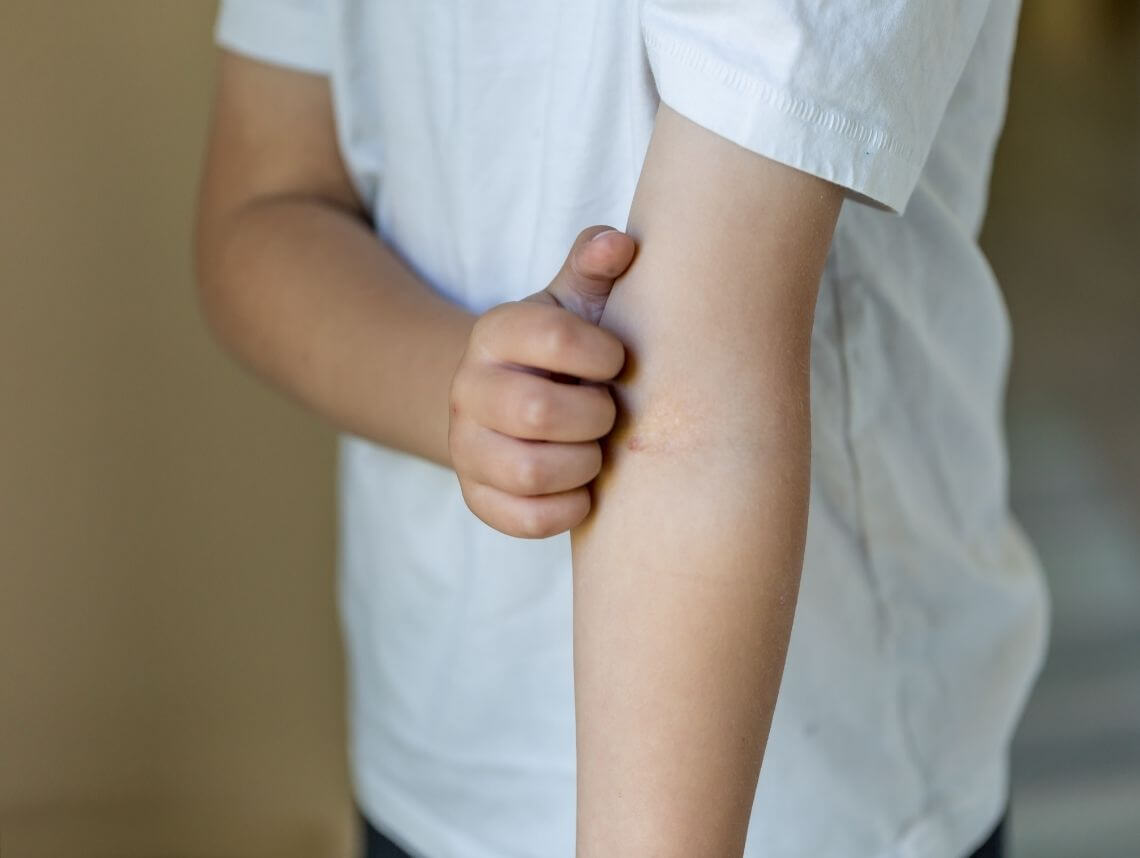The good news about scabies is that despite the discomfort and itching this condition causes, it is highly treatable, and the symptoms usually pass in a relatively short period of time. While no parent wants their child to come down with scabies, the truth is that anyone can develop it due to its very transmissible nature. To ensure the shortest possible duration of the itching and rashes that comes with a scabies outbreak in children, proper education and care is essential.
Scabies is caused by mites, microscopic arachnids, that burrow into the upper layers of the skin. The outbreak itself usually begins about two weeks after infestation and is the body’s reaction to proteins, eggs, and other matter left by the mites. Although scabies in children is common, it can happen in people of all ages.
The following guide can help you learn about the complete process of diagnosing and treating scabies in children. By being a more informed caretaker, you can be more engaged as you work with doctors and other health professionals to successfully manage this condition.
Scabies Transmission & Risk Factors
According to the Centers for Disease Control (CDC,) the scabies mite is almost always passed by prolonged, direct skin-to-skin contact with an infested person. An infested person does not need to have symptoms to pass the mite, and human scabies can only be spread by another person, not by animals.
Scabies spreads easily in crowded conditions where there is close and frequent contact, as well as shared clothing, towels, and blankets. This is why one of the most common sources of scabies infestation is child care facilities. Scabies in children can affect anyone and is found worldwide.
Pediatric Scabies Causes
In children, scabies is caused when the microscopic mites burrow into the top layers of the skin. There, they live and breed for weeks. The symptoms and discomfort from the infestation usually develops as a result of eggs and waste products from the colonies.
Pediatric Scabies Symptoms
Scabies in children usually causes the following symptoms:
- Rashes that most commonly appear on the head, neck, palms, and soles of the feet for younger children under two
- Rashes in older children that often appear in the fingers, wrists, elbows, waistline, thighs, buttocks, and genitals
- Extreme itching that may become worse at night
- Visible lines or marks from the burrowing mites
Some patients are at an increased risk of a form of scabies known as Norwegian, or crusted, scabies. This type of scabies can cause thick, crusted growths on the skin and is more highly transmissible due to the larger numbers of mites in this breed.
Pediatric Scabies Diagnosis
Parents who notice these symptoms or who are informed of a scabies outbreak in a school or childcare provider should seek immediate assistance from a pediatrician. A pediatrician will usually diagnose scabies based on a medical history review, questions about symptoms and activities, and a visual and physical examination.
In some cases, the doctor may examine a skin sample under a microscope to visually confirm the presence of the scabies mite.
Pediatric Scabies Treatment
Firstline treatment for scabies in children is usually medication in the form of a cream or lotion, which can kill the infestation in a short period of time. Parents will usually apply all over the skin, particularly in infected regions, and then wash it off in a bath after eight to 14 hours.
Symptoms, including the rash and itching, can continue in the following weeks. Pediatricians will usually recommend the following measures to help:
- Using a topical cream, such as hydrocortisone, to relieve inflammation
- Taking an oral antihistamine to relieve itching
- Keeping fingernails short to minimize scratching
Caring for a Child with Scabies
Once the infestation is cleared, children are usually able to return to school or childcare as normal. Follow-up care, including taking all prescribed medications and attending appointments is critical to a positive outcome. For parents or families with busy schedules, pediatric home health services can provide excellent assistance, particularly if your child is dealing with another condition or illness concurrently.
Long-term prevention is also important after a scabies infection. Keep all clothing and bedding clean to lower the chances of reinfection of scabies in children.
Contact Sonas for Home Health Care in Florida
It can be hard to balance your time between work, home, and caring for a child. That’s why our team of skilled professionals at Sonas Home Health Care is here to help. We have been enforcing precautionary measures and following the Centers For Disease Control (CDC) guidelines for COVID-19 to ensure the safety and health of our clients and employees.
Our home health care services offer support in the comfort of your home. We refer loving and competent nurses to provide customized care for families — from a few hours a day to around-the-clock supervision. Contact us directly to speak with a home health care professional or request a free in-home assessment. Together we can determine the best plan of action to keep your loved ones happy and healthy.
If you or a loved one are considering Pediatric Home Health Care Services in Florida, contact the caring staff at Sonas Home Health Care. Call today at (888) 592-5855.
This blog was reviewed by Jillian Miller BSN, RN — Director of Nursing for Sonas Home Health Care’s Tampa Bay market — for clinical accuracy. Jillian Miller has been a nurse for 16 years — working primarily in pediatrics. She believes the best part of working with the pediatric population is when you see smiles from clients when you first enter the room. She loves seeing the difference you can make in families’ lives while providing the best care possible for them.

